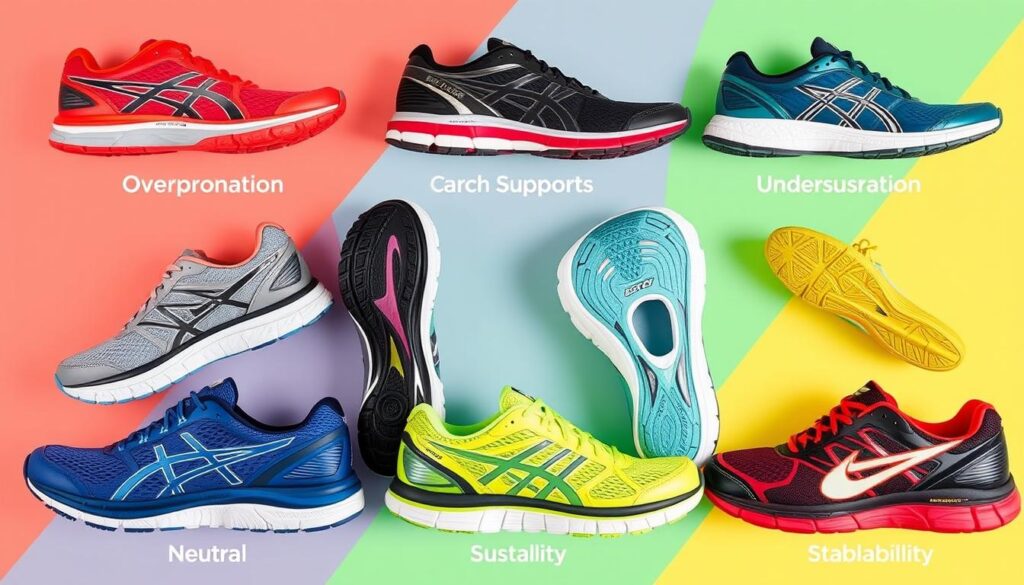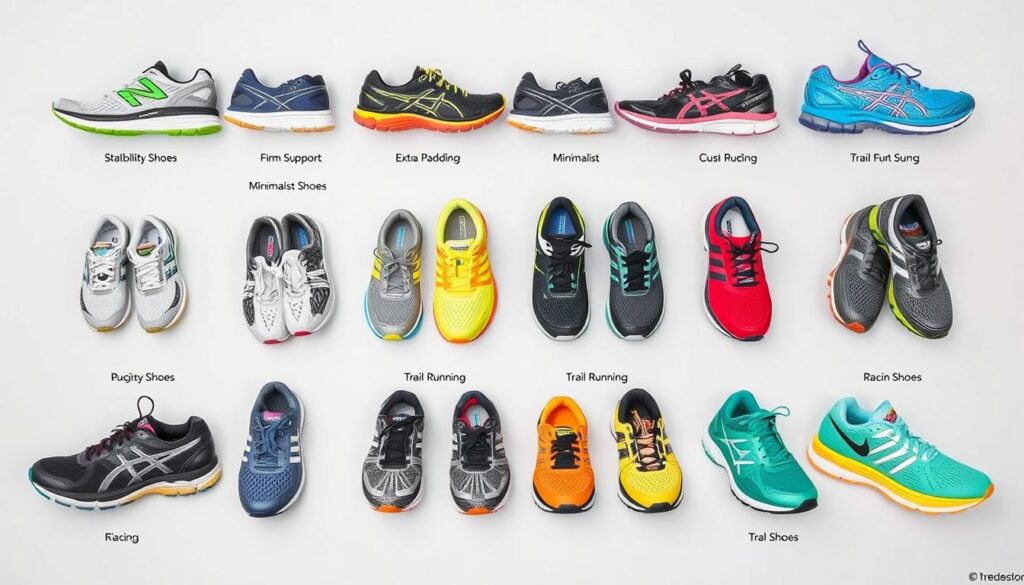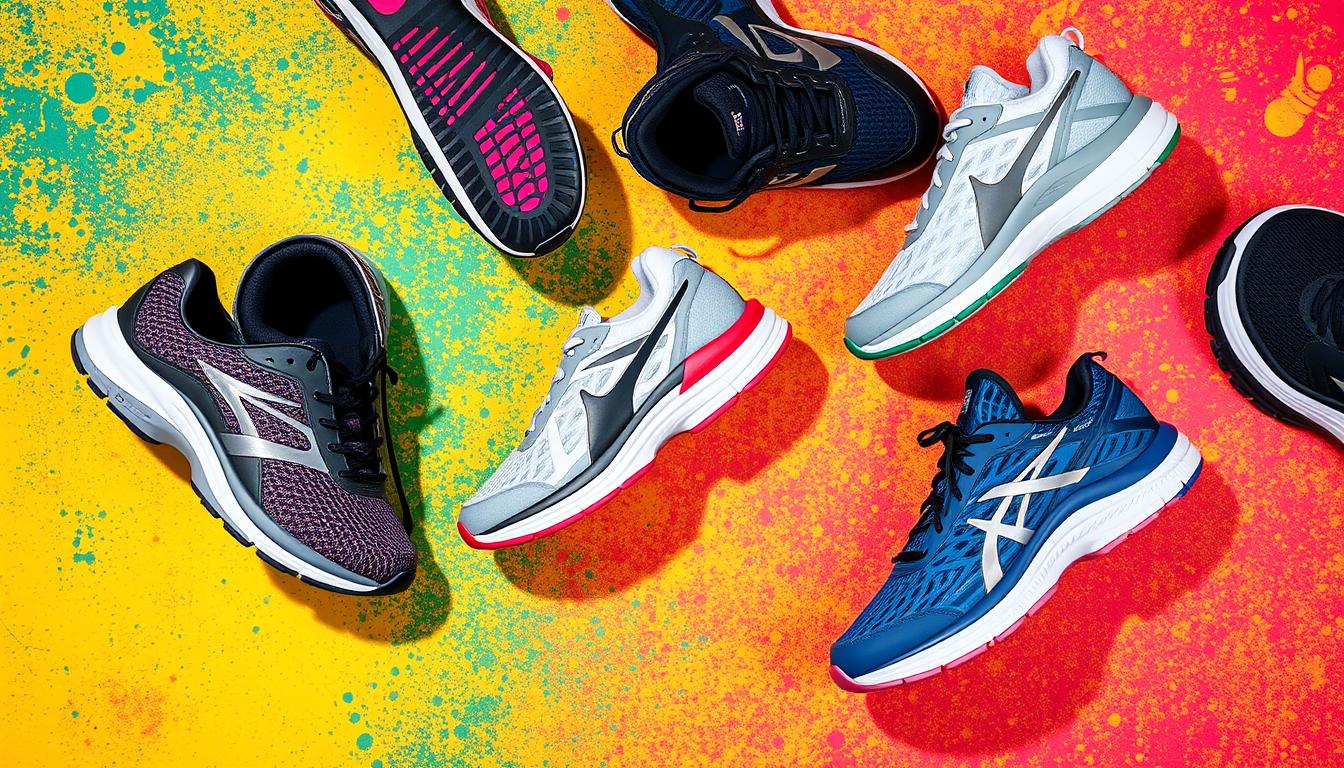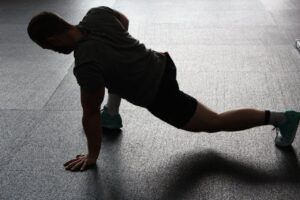Finding the right running shoes is crucial for your performance, comfort, and safety. With many options out there, it can be hard to choose the perfect pair. This guide will help you understand what to look for in running shoes that fit your needs.
Key Takeaways
- Know your foot type and how you pronate to pick the right shoe.
- Look at the cushioning and stability of different shoes to match your running style.
- Try on shoes and test them on different surfaces to ensure a good fit.
- Check the shoe’s features like the upper, midsole, and outsole for support and comfort.
- Replace your running shoes often to keep up performance and avoid injuries.
Understanding Your Feet and Gait
Choosing the right running shoes starts with knowing your foot type and gait. It’s important to figure out if you have a neutral, high-arched, or flat foot. Also, knowing if you pronate, supinate, or have a neutral gait helps find the best types of running shoes for different feet. This info is key for how to pick shoes for running that offer the right support and cushioning.
Foot Type and Arch Height
To find out your foot type, look at the imprint your wet foot makes on the ground. A clear arch means you have a high-arched foot. If your whole foot is visible, you might have a flat or low-arched foot. A medium-sized arch suggests a neutral or normal foot type.
Pronation: Neutral, Overpronation, or Underpronation
Pronation is the natural inward roll of your foot during walking or running. Neutral pronation is best, but some runners overpronate (roll too much inward) or underpronate (roll outward). Knowing your pronation pattern is vital for how to pick shoes for running that offer the right stability and control.
Understanding your foot type and pronation helps pick the best types of running shoes for different feet. This ensures you get the support, comfort, and performance you need on any surface.

Types of Running Shoes
When it comes to types of running shoes for different feet, there’s no one shoe for everyone. Running shoes are made for various foot types and running styles. Let’s look at the main types of running shoes to find the best fit for your feet.
Neutral Shoes
Neutral running shoes are perfect for runners with a normal gait and arch height. They offer a mix of cushioning and support. This lets your feet move naturally without too much rolling.
These shoes are great for runners looking for a comfortable and balanced ride.
Stability Shoes
Stability shoes are for runners who tend to overpronate. Overpronation is when your feet roll too much inward. These shoes have a firmer midsole and better arch support.
They help control this motion and improve your foot strike.
Motion Control Shoes
Motion control shoes are for runners with severe overpronation. They have a thick midsole and a strong heel counter. This limits how much your feet roll inward.
They’re best for runners with flat feet or low arches who need lots of support.
Cushioned Shoes
Cushioned running shoes are for those who want a soft and responsive ride. They have thick, soft midsoles for extra padding. These shoes are good for runners with high arches or who prefer a softer feel.

Choosing the right types of running shoes for different feet depends on your foot type, running style, and what you prefer. It’s key to try on different shoes. Find the one that offers the right mix of support, cushioning, and comfort for you.
Cushioning vs. Stability Shoes
When picking shoes for running, knowing the difference between cushioned and stability shoes is key. The right shoe can greatly improve your running and prevent injuries. Let’s look at what makes each type special and help you choose the best for your running style.
Cushioned Shoes for Neutral Runners
Cushioned shoes are for runners with a neutral gait. This means their feet don’t roll too much to the side. These shoes focus on comfort and shock absorption, offering a soft and responsive feel. If you have a neutral foot, a cushioned shoe can help reduce impact and protect your joints.
Stability Shoes for Overpronators
Stability shoes are for runners who overpronate, where the foot rolls too much inward. These shoes offer extra support and structure to control this motion. If you overpronate, a stability shoe can help keep your foot in the right position and prevent injuries like shin splints or knee pain.
When picking running shoes, it’s important to consider your foot type and running style. A professional at a specialty running store can help you find the right shoe. They can analyze your gait and suggest the best shoe for you.
“The right pair of shoes can make all the difference in your running experience. Invest the time to find the perfect fit for your feet and running style.”
Remember, comfort and support are crucial when choosing running shoes. By understanding the differences between cushioned and stability shoes, you’ll find the perfect pair. This will improve your running and keep you injury-free.
Choosing the Right Shoe Size
Finding the perfect fit is key when how to pick shoes for running. The right shoe size can greatly improve your comfort and performance. Here are some tips to help you find the ideal shoe size for your feet:
- Measure Your Feet: Use a Brannock device or measure your feet at the end of the day when they are slightly swollen. This will give you an accurate measurement of your foot size.
- Allow for Wiggle Room: Your running shoes should have a thumb’s width of space between your toes and the end of the shoe. This extra space will prevent your toes from hitting the front of the shoe during your runs.
- Consider Foot Swelling: Feet can swell up to a half-size during a run, so it’s important to account for this. Choose a shoe that will accommodate the swelling without feeling too tight.
- Try on Shoes Later in the Day: Your feet are typically larger in the evening, so try on shoes at the end of the day for the best fit.
- Ensure Proper Heel Fit: The shoe should fit snugly around your heel, with minimal slippage, to prevent blisters and ensure a secure fit.
By following these tips, you’ll find the perfect how to pick shoes for running. This will keep your feet comfortable and supported during your training and races.
“The right running shoe can make all the difference in your performance and enjoyment of the sport.”
Trying on Shoes and Testing Them
Finding the perfect running shoes is more than just picking a style or brand. It’s crucial to try them on and test them. This ensures they offer the right comfort, support, and fit for your feet. The in-store fitting and testing process is key to choosing the best how to pick shoes for running.
In-Store Fitting and Testing
When trying on running shoes, focus on a few important things:
- Comfort: The shoes should feel good and supportive from the start. Walk around and do a few short jogs to check comfort.
- Arch support: Make sure the shoes match your arch type, whether high, low, or neutral.
- Heel fit: The heel should fit snugly without slipping or rubbing.
- Toe box: There should be enough space for your toes to expand naturally during runs.
- Flexibility: Bend and twist the shoes to see if they’re flexible enough for you.
Choosing the right how to pick shoes for running is vital for comfort and performance. Spend time testing shoes in the store to find the perfect fit for your feet.
Considering Shoe Features
When picking shoes for running, knowing the key parts of a shoe is important. We’ll look at the upper, midsole, and outsole. These parts affect how well the shoe performs and lasts.
Uppers
The upper part of the shoe covers and holds your foot. It’s made from light, breathable materials like mesh or synthetic fabrics. It’s key for a comfy fit and keeping your feet cool and dry.
Midsoles
The midsole is between the upper and outsole. It gives cushioning and support. It’s made from foam or a mix of foam and special tech, like air pockets or gel. The right midsole depends on your running style and where you run.
Outsoles
The outsole is the shoe’s bottom, touching the ground. It’s made from tough rubber or other materials. Its design affects how well you run and how long the shoes last.
Knowing about running shoes helps you choose the right ones. Whether you need cushioning, stability, or are running on different terrains, understanding each part is crucial. It helps you find the perfect shoes for your running needs.
how to pick shoes for running
Choosing the right running shoes is key for a comfy and injury-free run. When picking shoes, consider a few important factors:
- Foot type and arch height
- Pronation pattern (neutral, overpronation, or underpronation)
- Cushioning and stability needs
- Shoe size and fit
- Terrain and running surface
- Personal preferences and running goals
First, know your foot type and pronation pattern. These will help you choose the right shoe. Neutral runners might prefer cushioned shoes. Overpronators need stability or motion control shoes to stop their foot from rolling too much.
| Foot Type | Arch Height | Pronation Pattern | Recommended Shoe Type |
|---|---|---|---|
| Low Arch (Flat Feet) | Low | Overpronation | Stability or Motion Control Shoes |
| Medium Arch | Medium | Neutral | Cushioned Shoes |
| High Arch | High | Underpronation | Cushioned Shoes with Extra Flexibility |
Also, think about where you’ll run and what you want from your shoes. The right how to pick shoes for running strategy can lead you to the perfect pair. They’ll support your feet and help you run comfortably and injury-free.
Replacing Your Running Shoes
Running shoes are key for good performance and injury prevention. They don’t last forever. Knowing when to get new shoes is important.
As you run more, your shoes lose cushioning and support. This can hurt your feet and joints.
Signs of Wear and Tear
Worn-out shoes are easy to spot. Look at the bottom for a thin tread. If it’s almost gone, your shoes can’t absorb shock well anymore.
Also, if the midsole feels too flat or the upper material is torn, it’s time for new shoes.
Changes in how your shoes feel during runs are important. Discomfort, pain, or tiredness in your feet, legs, or joints mean your shoes need a break.
Tracking your miles can help you know when to get new shoes. Most say to replace them after 300-500 miles.



